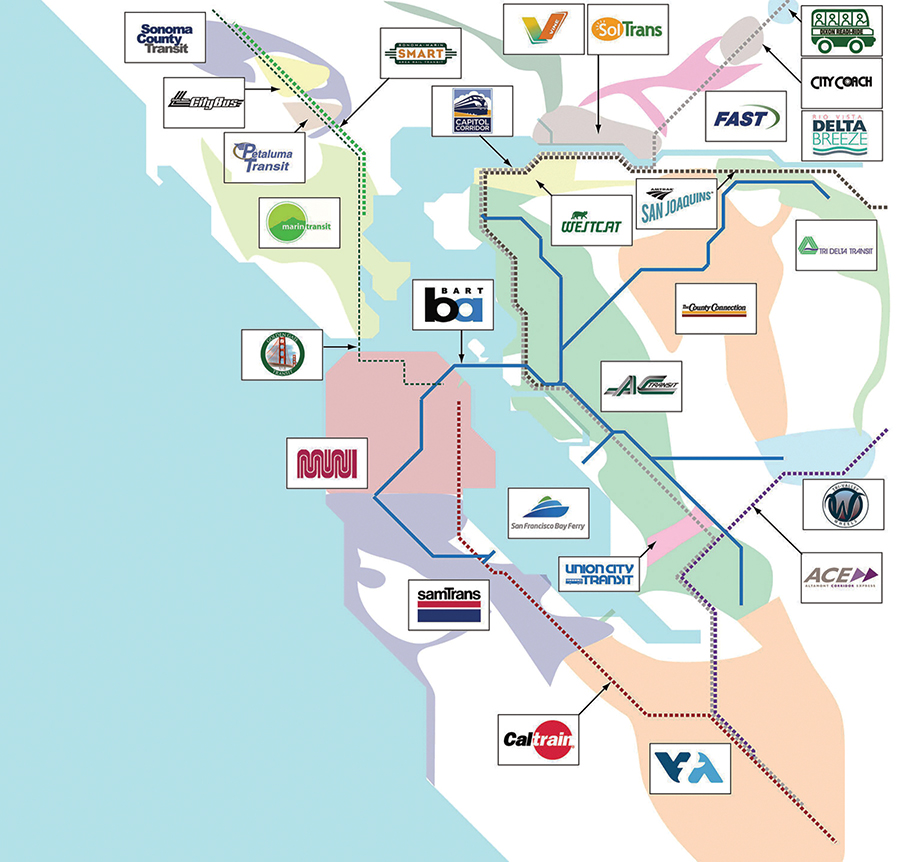
Seamless Bay Area wants to unify the region’s 27 transit agencies into an integrated network. Image courtesy Seamless Bay Area.
Since advocacy group Seamless Bay Area launched in 2018, it’s been asking people what prevents them from using transit and if any changes would compel them to choose bus and rail more often.
Their list generally calls for more connected, reliable, cost-effective, and easy-to-pay for travel — requests that aren’t necessarily unusual. But they are conversation pieces all the same that Seamless Bay Area keeps fresh at the transit reform table as officials chart the post-pandemic course forward.
Seamless Bay Area is pushing for changes to transform the region’s fragmented public transit system into something more unified and equitable to help people commute and travel easily, regardless of the transit agency. Twenty-seven transit agencies operate regionally, yet there is no single entity responsible for coordinating the transportation system as a whole.
Sara Barz, Seamless Bay Area board director and founding member, described a common pain point with room for improvement.
“The thing that made me crazy is that some people would not use Clipper on the bus and pay cash because they thought Clipper wouldn’t be accepted,” said Barz, summing up one rider’s overpayment mistake shared during a December forum on essential travelers’ needs.
Barz co-authored a 2015 SPUR report with Ratna Amin called Seamless Transit: How to make Bay Area public transit function like one rational, easy-to-use system that highlighted concerns about the Bay Area’s “patchwork” approach to transit. It contained analysis and strategies that helped form Seamless Bay Area’s seven guiding principles. These include running transit as one easy-to-use system, putting riders first, and making transit equitable and accessible to all.
“There was a position in that report that the region should do better for the rider,” Barz said. “It was a natural extension at some point that, when the region didn’t start acting on the report, somebody would.”
Seamless Bay Area is led by a core team of 10 professionals, many of whom have experience working at local transit systems. The group is helping shape regional transit advocacy, driving policy changes through creative programs and research, and alerting riders about opportunities to speak up about fare integration and other potential organizational changes.
That’s not to say there haven’t been other groups working to support Bay Area transit. San Francisco Transit Riders has advocated for bus and rail improvements since 2010. Friends of Caltrain started the same year to keep the commuter rail service running amid the threat of service cuts — financial woes that still plague the operator today. Caltrain’s board of directors is considering transit governance options, including a merger with BART, a regional rail service plan that Friends of Caltrain and Seamless Bay Area support.
Whether such a union will occur remains to be seen, but a new poll underscores interest. About 83 percent of respondents support combining BART and Caltrain into a single integrated system, according to the Bay Area Council, the public policy group that conducted the poll.
There are improvements swirling around other new transportation organizations. The East Bay Transit Riders Union (EBTRU) launched last year because there was “no real organized voice of bus riders” to respond when AC Transit temporarily suspended evening service during the George Floyd protests to meet counties’ curfew orders, said Derek Sagehorn, EBTRU co-founder. Outside of the Bay Area, Transit Forward Philadelphia got going last February to prioritize transit and combat ridership declines.
“It’s a reaction to what was a downward spiral in transit quality in a lot of American cities,” said Ben Fried, communications director at TransitCenter, a foundation based in New York that works to improve public transit. “The long-term trend in a lot of places is the bus keeps getting slower and fewer people are riding.”
Add to that a plunge in ridership nationwide due to COVID-19, and many were left wondering if transit would fully recover. Seamless Bay Area adjusted its focus during the onset of the pandemic to prioritize health and safety and help advocate for emergency funding to keep systems going, said Ian Griffiths, the group’s policy director.
The group also continued its advocacy work toward a unified regional transit system. But there were times when the message was “go away,” said Griffiths, describing what outreach with some transit managers was like given pandemic-driven funding concerns and other limitations.
“It was a fine line we had to walk, whereby we knew reforms were incredibly important, but at the same time, the whole world was upside down, and [governance reform] was certainly not the most urgent thing anymore,” added Griffiths, who resigned as a senior planner at BART two years ago to focus on advocacy full-time.
Some of that sentiment began to shift after federal CARES Act relief funding became available last year. Uncertainties surrounding rider demand still put pressure on transportation officials to think collaboratively to get Bay Area bus and rail systems rolling again.
Griffiths and the Seamless Bay Area team were ready. While the nonprofit doesn’t have a very long track record, it is increasing its influence. About 50 community groups, cities, transit agencies, and other public entities have adopted its guiding principles.
One of them is United Seniors of Oakland and Alameda County (USOAC). It would be easier for older people to “have one form of transit that takes care of everything,” said Chonita Chew, USOAC’s travel trainer/organizer.
Seamless Bay Area also is connecting with elected officials. The group was the primary sponsor of 2020’s Seamless Transit Act, introduced by San Francisco Assemblymember David Chiu in early 2020. While the bill was shelved due to the pandemic, one of its key recommendations — a task force — was realized when the Metropolitan Transportation Commission assembled one last May. The Blue Ribbon Transit Recovery Task Force invited Seamless Bay Area and 31 other elected officials, professionals, and groups to help direct a regional transportation path forward.
“I think that’s in recognition of the thought leadership and interest we bring to this topic through our vision map work and our advocacy on fare integration,” Griffiths said.
Its new report, Governing Transit Seamlessly, outlines options to coordinate regional transit by establishing a network manager. Released in April, the report analyzed several options and concluded that a network manager led by a regional transit agency is the route toward seamless, rider-first transit.
“Among the options we assessed, a nine-county agency that brings together BART, Caltrain, and other regional bus and ferry services under one roof, led by a board with a significant number of appointed experts with relevant backgrounds, is best positioned to be effective in delivering a seamless customer experience, expand access to all, and adapt and change over time,” according to the report.
In response to concerns that this type of governing body might further confuse coordination and decision-making, Griffiths pointed to successful network management examples in other regions like Europe.
“We believe an existing agency should be reformed to become the network manager,” he said. “We don’t support creating a net new agency, which, if layered on top of the existing unreconciled agencies, would indeed create additional bureaucracy.”
Meanwhile, state legislation continues to advance the goal of seamless transit and proposes MTC handle some of the details. Assembly Bill 629 (Chiu) calls on MTC to work with agencies to design a single regional transit map, standardize wayfinding mechanisms, and report real-time transit data across the region.
Beyond engaging with transit agencies, Seamless Bay Area hustles to connect with riders. Pre-pandemic, it staffed information booths at outdoor events and worked on its “Transit Stories” project to record people’s thoughts on local transit and experiences riding and transferring.
The group also frequently posts action alerts, so riders know about opportunities to speak up during transit policy reform meetings. Last fall, it created a Connect the Bay transit board game based on its fare vision map and supported by an online donation campaign.
Said Griffiths: “I feel like we’ve made some breakthroughs in the past several months to get to this point, and I’m pretty optimistic as far as the future of Seamless Bay Area.”
Cecily O’Connor covers transportation for the Monitor.

